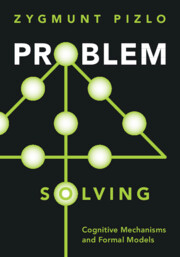Book contents
- Problem Solving
- Problem Solving
- Copyright page
- Dedication
- Contents
- Figures
- Tables
- Preface
- Chapter 1 Problem Solving
- Chapter 2 Animal Problem Solving
- Chapter 3 Modern Research on the Human Ability to Solve Problems that Have Large Search Spaces
- Chapter 4 The Exponential Pyramid Representation that Compensates for Exponentially Large Problem Spaces
- Chapter 5 Heuristic Function, Distance, and Direction in Solving Problems
- Chapter 6 Insight and Creative Thinking
- Chapter 7 Inference in Perception
- Chapter 8 Cognitive Inferences, Mental Representations
- Chapter 9 Theory of Mind
- Chapter 10 Solving Problems in Physics and Mathematics
- Chapter 11 Summary and Conclusions
- References
- Index
Chapter 6 - Insight and Creative Thinking
Published online by Cambridge University Press: 23 June 2022
- Problem Solving
- Problem Solving
- Copyright page
- Dedication
- Contents
- Figures
- Tables
- Preface
- Chapter 1 Problem Solving
- Chapter 2 Animal Problem Solving
- Chapter 3 Modern Research on the Human Ability to Solve Problems that Have Large Search Spaces
- Chapter 4 The Exponential Pyramid Representation that Compensates for Exponentially Large Problem Spaces
- Chapter 5 Heuristic Function, Distance, and Direction in Solving Problems
- Chapter 6 Insight and Creative Thinking
- Chapter 7 Inference in Perception
- Chapter 8 Cognitive Inferences, Mental Representations
- Chapter 9 Theory of Mind
- Chapter 10 Solving Problems in Physics and Mathematics
- Chapter 11 Summary and Conclusions
- References
- Index
Summary
We are now halfway through our book. It may appear to be a coincidence that insight and creative thinking appear at the “center” of a book on problem solving, a coincidence that the gestalt psychologists would surely have liked. Contemplating how the young Gauss solved an arithmetic problem, and considering how a mutilated checkerboard problem is solved, while realizing that the solution of these problems are analogous to how snowflakes look, may come as a surprise. It should not because all three are based on symmetry and invariance. Before discussing how “ordinary” insight problems are solved, this chapter describes the insights that led Galileo, Archimedes, and Einstein to their scientific discoveries. Physicists have known for over a century that there would be no science based on the natural laws, and no natural laws in the first place, if there were no symmetry in nature. So what encouraged this to happen just over a 100 years ago? In 1918, Emmy Noether formulated and proved her mathematical theorems that revolutionized physics. Her theorems showed how the conservation laws can be derived from the symmetry of these laws by applying a least-action principle. The review of symmetry in scientific discovery presented in this chapter provides the stage for a new formalism of problem solving that may apply not only to the sophisticated areas of science, but also to “ordinary” brain teasers, as well as to the TSP and the 15-puzzle.
- Type
- Chapter
- Information
- Problem SolvingCognitive Mechanisms and Formal Models, pp. 94 - 110Publisher: Cambridge University PressPrint publication year: 2022

